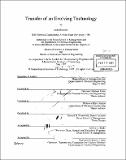| dc.contributor.advisor | Michael Cima and Klavs Jensen. | en_US |
| dc.contributor.author | Houston, Brad | en_US |
| dc.contributor.other | Leaders for Manufacturing Program. | en_US |
| dc.date.accessioned | 2006-11-08T16:24:38Z | |
| dc.date.available | 2006-11-08T16:24:38Z | |
| dc.date.copyright | 1995 | en_US |
| dc.date.issued | 1995 | en_US |
| dc.identifier.uri | http://hdl.handle.net/1721.1/34715 | |
| dc.description | Thesis (S.M.)--Massachusetts Institute of Technology, Sloan School of Management; and, (S.M.)--Massachusetts Institute of Technology, Dept. of Chemical Engineering; in conjunction with the Leaders for Manufacturing Program at the Massachusetts Institute of Technology, 1995. | en_US |
| dc.description | Includes bibliographical references. | en_US |
| dc.description.abstract | This thesis follows the transfer of a thin film from development to manufacturing. Problems of differences in equipment and differences in manufacturing methods were overcome to complete the transfer. The film was characterized using UV-Visible, FTIR, and Raman spectroscopy. Hydrogen forward scattering, surface bead angle, and atomic force microscopy were also employed. A series of experiments was conducted to: 1) Analyze the impact of deposition parameters on the performance of the film. 2) Match the performance of films produced in the manufacturing site to the performance of films produced in the development site. Both the development and manufacturing sites were acquired by a new company during the period of this transfer. The cultures of the development and manufacturing sites had not merged before this occurred. This fact, coupled with subsequent reorganization undertaken by the new management, has the potential to slow product introductions. The transfer of this film was successful despite the organizational upheaval occurring at the same time. Three factors contributed to this success: 1) The development engineer stayed with the process throughout the transfer to manufacturing. 2) The collaboration of upstream manufacturing steps integrated the new process with the existing line. 3) Early involvement of manufacturing speeded acceptance and lessened training costs. Recommendations to better link the manufacturing and technology development groups, based on observations made during work on the film transfer, are presented for management's consideration. Key among these is the establishment of common goals and the building of a communication infrastructure between the two sites. | en_US |
| dc.description.statementofresponsibility | by Brad Houston. | en_US |
| dc.format.extent | 88 p. | en_US |
| dc.format.extent | 5456909 bytes | |
| dc.format.extent | 5461090 bytes | |
| dc.format.mimetype | application/pdf | |
| dc.format.mimetype | application/pdf | |
| dc.language.iso | eng | en_US |
| dc.publisher | Massachusetts Institute of Technology | en_US |
| dc.rights | M.I.T. theses are protected by copyright. They may be viewed from this source for any purpose, but reproduction or distribution in any format is prohibited without written permission. See provided URL for inquiries about permission. | en_US |
| dc.rights.uri | http://dspace.mit.edu/handle/1721.1/7582 | |
| dc.subject | Sloan School of Management. | en_US |
| dc.subject | Chemical Engineering. | en_US |
| dc.subject | Leaders for Manufacturing Program. | en_US |
| dc.title | Transfer of an evolving technology | en_US |
| dc.type | Thesis | en_US |
| dc.description.degree | S.M. | en_US |
| dc.contributor.department | Leaders for Manufacturing Program at MIT | en_US |
| dc.contributor.department | Massachusetts Institute of Technology. Department of Chemical Engineering | |
| dc.contributor.department | Sloan School of Management | |
| dc.identifier.oclc | 47006063 | en_US |
